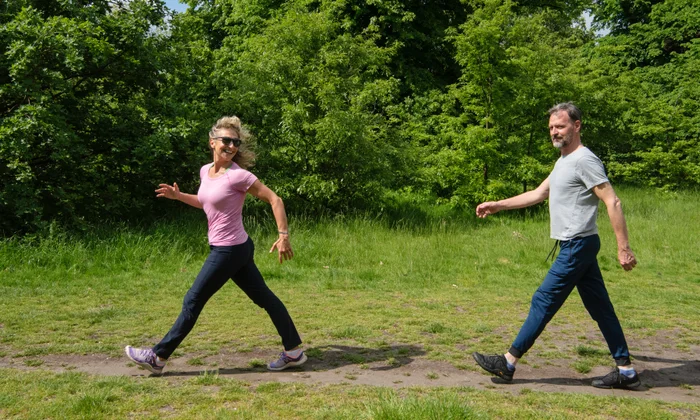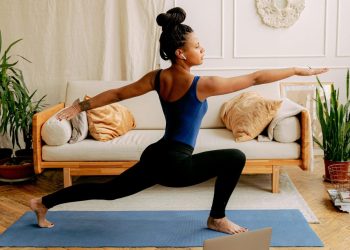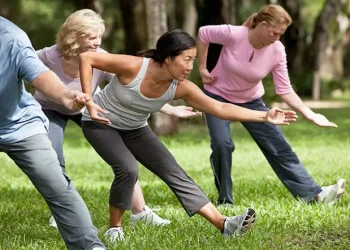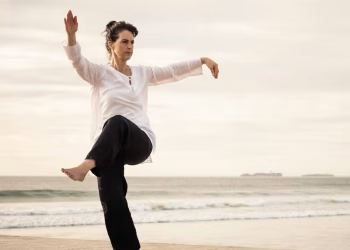Walking is one of the most fundamental human movements, yet many of us do it incorrectly due to years of accumulated bad habits, sedentary lifestyles, and modern work environments. Poor walking posture doesn’t just affect your appearance—it can lead to chronic pain, reduced energy levels, breathing difficulties, and increased risk of injury. The good news is that with awareness, practice, and the right techniques, you can dramatically improve your walking posture and reap significant health benefits.
Understanding Proper Walking Posture
Before correcting your posture, you need to understand what correct posture looks like. Proper walking posture involves alignment from head to toe:
Head and Neck: Your head should be balanced directly over your spine, with your ears aligned over your shoulders. Your chin should be parallel to the ground, not jutting forward or tucked down. Imagine a string pulling the crown of your head gently upward.
Shoulders: Your shoulders should be back and down, relaxed rather than hunched or elevated toward your ears. They should move naturally with your arm swing but remain relatively stable.
Chest and Spine: Your chest should be open and lifted, allowing for full breathing capacity. Your spine maintains its natural S-curve—not overly arched in the lower back or rounded in the upper back.
Core: Your abdominal muscles should be gently engaged, providing stability to your pelvis and lower back without rigid tension.
Pelvis: Your pelvis should be in a neutral position, not tilted excessively forward or backward. This helps maintain the natural curve of your lower spine.
Legs and Feet: Your feet should point forward, with your heel striking first followed by a roll through to your toes. Your knees should track over your toes, not caving inward or bowing outward.
Common Walking Posture Problems
Identifying your specific issues is the first step toward correction:
Forward Head Posture: Often called “text neck,” this occurs when your head juts forward, placing strain on neck muscles and cervical vertebrae. This is increasingly common due to smartphone and computer use.
Rounded Shoulders: When shoulders roll forward and the upper back rounds, it compresses the chest cavity and can lead to shoulder pain and breathing difficulties.
Anterior Pelvic Tilt: This occurs when your pelvis tilts forward, causing an exaggerated arch in your lower back. It’s often caused by tight hip flexors and weak abdominal muscles.
Looking Down While Walking: Many people habitually look at the ground a few feet ahead rather than maintaining a forward gaze, which compromises neck and spine alignment.
Uneven Weight Distribution: Favoring one leg or walking with turned-out feet can create imbalances throughout your kinetic chain.
Techniques to Correct Walking Posture
The Foundation: Static Posture Check
Before you walk, learn to stand correctly. Practice this daily:
Stand against a wall with your heels, buttocks, shoulder blades, and head touching the wall. There should be small gaps at your neck and lower back (where the natural curves are). This is your neutral alignment. Memorize how this feels, then step away and try to maintain it.
The Walking Reset Technique
Throughout your day, use this quick reset:
- Stop and take a deep breath
- Roll your shoulders up, back, and down
- Lengthen your spine by imagining the crown of your head reaching toward the sky
- Engage your core gently
- Resume walking with this renewed awareness
The Focal Point Method
Choose a point at eye level on the horizon and walk toward it. This naturally lifts your gaze and aligns your head and neck properly. Every few minutes, reset your focal point to maintain awareness.
The String Visualization
Imagine a golden thread attached to the crown of your head, gently pulling you upward. This mental cue helps elongate your spine and prevent slouching. Many people find this visualization more effective than thinking about multiple body parts simultaneously.
Mindful Heel-to-Toe Rolling
Pay attention to your foot strike. Your heel should contact the ground first, then roll smoothly through your midfoot to your toes. Push off with your toes rather than lifting your whole foot. This creates a smooth, efficient gait.
Arm Swing Coordination
Let your arms swing naturally from your shoulders, not your elbows. Your arms should swing forward and back (not across your body), with the opposite arm moving forward as each leg steps forward. Keep your hands relaxed, not clenched.
Exercises for Better Alignment
Daily Exercises (10-15 minutes)
Chin Tucks Sit or stand with neutral spine. Gently draw your chin straight back, creating a “double chin.” Hold for 5 seconds. Repeat 10 times. This strengthens deep neck flexors and counteracts forward head posture.
Wall Angels Stand with your back against a wall, feet slightly forward. Raise your arms to form a “W” shape against the wall. Slowly slide your arms up to form a “Y,” keeping contact with the wall. Return to “W.” Repeat 10-12 times. This improves shoulder mobility and strengthens upper back muscles.
Cat-Cow Stretch On hands and knees, alternate between arching your back (cow) and rounding it (cat). Move slowly and deliberately, spending 3-5 seconds in each position. Repeat 10 times. This mobilizes your entire spine.
Hip Flexor Stretch Kneel on one knee with the other foot forward (like a proposal position). Keeping your torso upright, gently push your hips forward until you feel a stretch in the front of your hip. Hold for 30 seconds each side. Repeat 2-3 times. Tight hip flexors are a major cause of poor posture.
Glute Bridges Lie on your back with knees bent and feet flat. Squeeze your glutes and lift your hips toward the ceiling, creating a straight line from shoulders to knees. Hold for 2 seconds at the top. Lower and repeat 15-20 times. This strengthens glutes and counteracts anterior pelvic tilt.
Thoracic Extension Sit in a chair with hands behind your head. Gently arch backward over the chair back, focusing on bending through your mid-back, not your lower back. Hold for 5 seconds. Repeat 10 times. This combats the rounded upper back from sitting.
Core Engagement Practice Stand or sit with neutral spine. Draw your belly button toward your spine about 30%, enough to feel engagement but not so much that you can’t breathe comfortably. Hold while breathing normally for 30 seconds. Repeat 5 times. Practice this until it becomes automatic during walking.
Weekly Strength Training
Planks: Build core stability essential for maintaining posture. Start with 20-30 seconds, gradually increasing to 60 seconds or more.
Rows: Whether with dumbbells, resistance bands, or at the gym, rowing movements strengthen the muscles that pull your shoulders back and down.
Deadlifts: When performed correctly with proper form, deadlifts strengthen the entire posterior chain—glutes, hamstrings, and back muscles crucial for upright posture.
Long-Term Strategies for Lasting Change
Create Environmental Cues
Place sticky notes or set phone reminders throughout your day to check your posture. Position mirrors strategically so you can see your side profile while walking. These external cues help build awareness until good posture becomes automatic.
Optimize Your Daily Environment
Adjust your workspace: Monitor at eye level, chair supporting your lower back, feet flat on the floor. These ergonomic changes support good posture even when you’re not actively thinking about it.
Evaluate your sleeping position: A supportive pillow that keeps your head aligned with your spine and a mattress that supports your body’s natural curves contribute to better posture throughout the day.
Check your footwear: Shoes with proper arch support and cushioning affect your entire kinetic chain. Avoid consistently wearing high heels or completely flat shoes.
Practice Progressive Awareness
Start by dedicating just 5 minutes daily to conscious posture practice during a short walk. Gradually extend this period. Eventually, good posture will require less conscious effort as new neuromuscular patterns develop—typically within 3-6 months of consistent practice.
Incorporate Movement Variety
Don’t just walk—include different types of movement in your routine. Yoga, Pilates, swimming, and tai chi all promote body awareness and postural control. Cross-training prevents repetitive strain and builds balanced strength.
Address Underlying Issues
If you have chronic pain or significant postural deviations, consider consulting professionals:
- Physical therapists can assess biomechanical issues and create personalized treatment plans
- Chiropractors may help with alignment issues
- Personal trainers certified in corrective exercise can design targeted programs
Track Your Progress
Take photos from front and side views every 4 weeks. Objective visual feedback can be motivating and help you notice improvements you might otherwise miss. Keep a journal noting pain levels, energy, and how your clothes fit—all indicators of postural improvement.
Build a Sustainable Routine
Consistency matters more than intensity. A 10-minute daily practice beats an hour-long session once a week. Schedule your posture work like any other important appointment. Link it to existing habits—posture check after brushing teeth, stretching during TV commercials, or a mindful walk during lunch breaks.
Stay Patient and Compassionate
You’re reversing years or decades of patterns. Some days will feel like regression. Progress isn’t linear. Celebrate small wins: less neck tension after desk work, walking a mile without fatigue, or simply catching yourself slouching before it becomes prolonged.
Improving your walking posture is a journey, not a destination. The techniques and exercises outlined here provide a comprehensive framework, but personalization is key. Pay attention to your body’s feedback, adjust approaches based on what works for you, and remember that every step with better alignment contributes to long-term health benefits.
Better posture isn’t about rigidity or military-style bearing—it’s about efficient, aligned movement that allows your body to function optimally. As you practice these techniques, you’ll likely notice improvements beyond walking: better breathing, reduced pain, increased energy, enhanced confidence, and overall improved quality of life.
Start today with just one technique or exercise. Your future self will thank you for every mindful step you take toward better posture.






